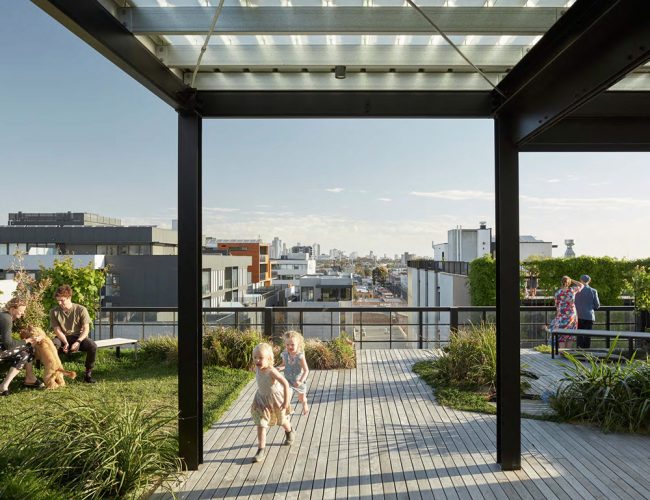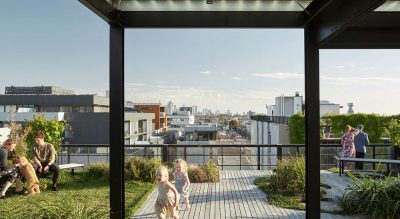Nightingale Housing assists Australia’s leading architects to deliver carbon neutral housing at-cost. As an organisation Nightingale Housing cares deeply about the environment; that’s why Nightingale homes are not plumbed with gas and achieve an exceptional energy rating (minimum 7.5 stars NatHERS). Shared amenity such as a communal laundry and solar array minimise inhabitants collective footprint.
Located in the ground floor of Nightingale 1 (Brunswick, Melbourne) the Nightingale office is able to minimise carbon emissions as the building is fossil fuel free in operations. Nightingale Housing has committed to undertaking an annual NoCO2 audit and offsets its emissions so that it can be carbon neutral, just like it’s buildings.
Environmental Action:
Nightingale Housing is a NoC02 business certified by the Carbon Reduction Institute (CRI) under the NoCO2 Program. To achieve this status and become carbon neutral Nightingale Housing undertook the following process:
- Commissioned a NoCO2 audit from CRI to measure their carbon footprint, through the determination of the GHG emissions that resulted from their operations over the 2018 financial year (FY2018). CRI’s NoCO2 audit follows the standards outlined by the World Business Council for Sustainable Development’s Greenhouse Gas Protocol Corporate Accounting and Reporting Standard (1), in addition to the international standard ISO 14064.1 (2).
- Have committed to offset their unavoidable emissions through the purchase of units in approved projects under the Verified Carbon Standard (VCS), and
- Nightingale Housing have committed to ongoing annual auditing of their emissions.
What does NoCO2 mean?
By meeting the requirements of the NoCO2 Program, Nightingale Housing is now a carbon neutral business. All services provided by Nightingale Housing are carbon neutral and cam display the Carbon Neutral Service Logo issued by CRI to Nightingale Housing.
What Carbon Credit Projects does Nightingale Housing purchase units from?
India: Clean energy from biomass
Environmental problems in India are growing rapidly. The increasing economic development and a rapidly growingpopulation that has taken the country from 300 million people in 1947 to more than one billion people today isputting a strain on the environment, infrastructure, and the country’s natural resources.
India’s air pollution is exacerbated by its heavy reliance on coal for power generation. Coal supplies more than halfof the country’s energy needs and is used for nearly three-quarters of electricity generation. While India is fortunateto have abundant reserves of coal to power economic development, the burning of this resource, especially giventhe high ash content of India’s coal, has come at a cost in terms of public health risk and environmental degradation.
Reliance on coal as the major energy source has led to a nine-fold jump in carbon emissions over the past forty years.The government estimates the cost of environmental degradation has been running at 4.5% of GDP in recent years.
Biomass projects are implemented in small or large industrial plants. Their aim is to utilize agricultural waste or other non-renewable biomass residues as fuel to generate power and to lower the plants’ dependence on the local grid for electricity. Before the implementation of the project, the electricity needs of such plants were met by power from a coal dominated grid. To meet the rising energy demands in production, a new efficient biomass boiler was installed together with a steam turbine, producing both steam and electricity. The new boilers are fuelled with locally available agricultural waste instead of traditional, emission intensive coal.
Before the start of the project, these agricultural residues were not used. They were either burned without harnessing the resulting thermal energy, or simply left to decay, thereby generating methane emissions. The plant’s steam and electricity requirements can be now supplied by the new cogeneration unit. The investment required for the installation of the new cogeneration unit could not have been raised were it not for the revenue from sales of carbon credits.
Beyond the reduction of greenhouse gases these projects contribute to local sustainable development by:
- Creating jobs in the construction, maintenance, and operation of the plant as well as in the biomass logistics
- Creating additional income for farmers from agricultural waste
- Alleviating the load on the unstable regional electricity grid, while providing a steady supply of electricity to the plant
- Reducing emissions of air pollutants from fossil fuel burning like SO2, soot and particulate matter
- Demonstrating and spreading renewable energy technology
- Creating a business case for regional empowerment through environmentally friendly technology
- By utilizing locally available, sustainable fuel sources thereby reducing the dependence on energy imports on a national level







